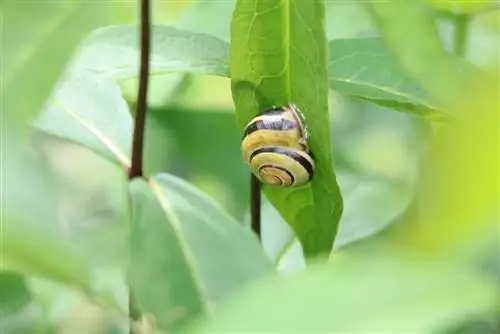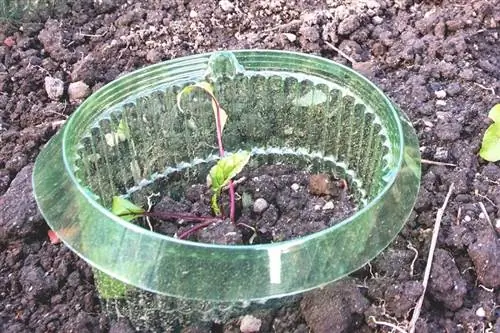- Author admin [email protected].
- Public 2023-12-17 03:39.
- Last modified 2025-01-24 12:45.
Snails in the garden are a nuisance, especially when they become a nuisance and can no longer be removed by simply picking them up. They eat the leaves of flowers, vegetable plants and bushes and ensure that plants die or only produce low yields. A snail fence is one of several natural methods you can use to control snails.
Prevent snails from multiplying in the garden
Snails can multiply almost explosively in the garden and become a real problem for the gardener. A single snail is capable of laying around 400 eggs. Filing takes place in autumn. The young animals hatch in spring. Since snails move very slowly and are therefore unable to look for a new habitat, they will settle in your garden. The animals feed primarily on leaves. They can crawl up plants and are thus able to eat entire flowers, vegetable plants or bushes. As a result, the plant dies or withers away. While a shrub has a chance to recover next year, the summer flower will wither.
Protect your plants by fighting the snails. A fence can serve very well here. You can purchase such a fence commercially or you can build it yourself. Suitable materials are metal, especially copper, or plastic. If you want to keep the snails away with a fence, there are a few things you should keep in mind when it comes to both the design and the structure.
Use a snail fence to combat snails
Once you have removed all the eggs in the fall, you need to remove the adults the following year. In addition to home remedies such as s alt or coffee grounds and chemical snail control products, you have the option of keeping the animals away from your plants with a fence. You can isolate the snails from your plants quite effectively using this method, but if you also want to fight the animals, you need a product that not only deters the snails, but also destroys them.
Requirements for a snail fence
If you want to install the fence, it must have a special structure. The animals must not be able to climb over the fence and there should be no loopholes. You can get special snail fences commercially that meet these requirements. When installing, keep in mind that the augers are slow but very maneuverable. They manage to get over a fence. For this reason, special requirements are placed on the construction of the fence.
When installing, insert the snail fence about 15 cm deep into the ground. This will prevent animals from crawling through the fence. Snails burrow into the ground, but they can't go that deep. Therefore, make sure to maintain at least this depth.

The fence is about 10 cm high. This will prevent the snail from climbing over the fence. The animals will try to climb over the fence. However, they cannot do this because a classic fence is curved at the top. It is important that you install the fence so that the curved side faces you. This means the snail cannot get over the fence. She falls back to earth. Since the fence is very low, the snail cannot hurt itself if it falls down.
Snail fence must not be covered by plants
After installation, it is important that you ensure that the fence is free of plant growth. If leaves lay over the fence, this can attract the snails. Additionally, leaves hanging over the fence can render the fence ineffective. The snail climbs the plant and crawls over the fence. Therefore, always set up the fences completely freely and regularly check the plant growth around the fence. In this way you ensure that your beds and plants behind the fence are really protected from the snails.
Insert metal snail fence
The metal snail fence combines various advantages. It is robust, durable and can remain permanently in the ground. It is also important that the material keeps the snails away. If you use copper, the snails can die if they come into contact with the fence. In this way you achieve a double effect because you protect your plants and ensure that animals die if they come into contact with the fence. If you manage to remove the eggs from your garden in the fall, you can assume that you have overcome the plague. It will certainly happen that individual animals return. You can then collect these from the plants.
Tip:
Check every autumn whether the animals have laid fresh eggs and remove the eggs carefully.
Install plastic snail fence
A plastic snail fence can also keep the animals away from your plants. However, unlike metal, the material is not harmful to animals. This means that your plants can still be damaged, namely if the animals manage to climb over the fence. Plastic snail fences have the advantage that they are even more robust than metal fences. What this means for you is that you can leave the fence in the ground for many years without it rusting or weathering. The material is also very inexpensive.
There are special fences available on the market for snail control, the height and structure of which are adapted to the needs. However, you can only use fences made of plastic material to prevent animals from getting to your plants. However, the snails will remain alive and you will have to fight the animals differently if you want to finally get rid of the plague.
Tip:
The plastic fence is cheaper to buy, while the metal fence is slightly more effective. You should consider these two aspects before deciding on one of the two materials.
Wooden fences
You may be thinking of installing a wooden fence because it looks more visually appealing. However, this method is not suitable for snails. The animals can attach themselves perfectly to the wood and climb up the fence. This would have made the fence ineffective.
Install electric fence to combat animals
An electric fence is powered by a battery and gives the animal a slight electric shock that will not kill it. It is effective because the snail cannot overcome the fence. However, the costs are high and the installation effort is large. They require batteries that need to be constantly changed and you need to keep the contacts clean. If they become covered with dirt or moisture gets inside, their effectiveness will be greatly reduced.
Build your own fence to combat snails

With a little craftsmanship, you can build a fence yourself to combat snails. You need copper wire that should be at least five millimeters thick. This makes it easy to bend. Note the height of 30 to 35 cm, sinking 15 cm into the ground. Bend the copper wire so that it creates a fine mesh that the animals cannot penetrate. Bend the top side five to four inches to the side at a right angle and install the fence so the curved side faces you. In this way you have made a snail fence very inexpensively.
Cost of purchasing in stores
When you buy a fence commercially, you get different variants that differ in design and price. For a metal fence you pay around 30 EUR for ten meters. Plastic fences are slightly cheaper at around EUR 20 for ten meters in length. Alternatively, you can also get metal sheets and transparent walls at a height of about ten centimeters, which the animals cannot overcome.
Fighting snails with home remedies is more effective
If you have to deal with a lot of snails in your garden, a fence can prevent the animals from getting to your plants in the medium term. In this regard, setting up the fence makes sense in any case. But it should be a measure that you combine with other measures. If you just put up a fence to control the snails, you will ensure that the animals settle in larger numbers. They stay alive, lay more eggs and the cycle is not broken. For this reason, it is important that you either collect the animals or fight them with home remedies. Place s alt or coffee grounds in front of the fence. The animals will gather there and die from the household remedies. By combining several measures, you can prevent the snails from spreading unhindered in your garden.






